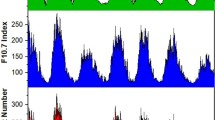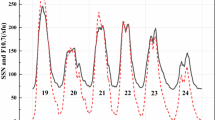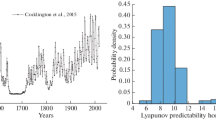Abstract
The analysis of long memory processes in solar activity, space weather and other geophysical phenomena has been a major issue even after the availability of enough data. We have examined the data of various solar parameters like sunspot numbers, 10.7 cm radio flux, solar magnetic field, proton flux and Alfven Mach number observed for the year 1976–2016. We have done the statistical test for persistence of solar activity based on the value of Hurst exponent (\(H\)) which is one of the most classical applied methods known as rescaled range analysis. We have discussed the efficiency of this methodology as well as prediction content for next solar cycle based on long term memory. In the present study, Hurst exponent analysis has been used to investigate the persistence of above mentioned (five) solar activity parameters and a simplex projection analysis has been used to predict the ascension time and the maximum number of counts for 25th solar cycle. For available dataset of the year 1976–2016, we have calculated \(H = 0.86\) and 0.82 for sunspot number and 10.7 cm radio flux respectively. Further we have calculated maximum number of counts for sunspot numbers and F10.7 cm index as \(102.8\pm 24.6\) and \(137.25\pm 8.9\) respectively. Using the simplex projection analysis, we have forecasted that the solar cycle 25th would start in the year 2021 (January) and would last up to the year 2031 (September) with its maxima in June 2024.



Similar content being viewed by others
References
Adams, M., Hathaway, D.H., Stark, B.A., Musielak, Z.E.: Sol. Phys. 174, 341–355 (1997). doi:10.1023/A:1004972624527
Ahmed, A.H.: J. Adv. Res. 4, 209–214 (2013)
Archibald, D.: Solar cycle 24: implications for the United States. In: International Conference on Climate Change (2008)
Callebaut, D.K.: Approach of a deep minimum in cycle 26 and effect on climate. In: First Middle East and Africa IAU-Regional Meeting Proceedings-MEARIM, pp. 227–230 (2008)
Carbonell, M., Oliver, R., Ballester, J.L.: Astron. Astrophys. 274, 497–504 (1993)
Clilverd, M.A., Clarke, E., Ulich, T., Rishbeth, H., Jarvis, M.J.: Space Weather 4(9) (2006)
Crutchfield, J.P.: Prediction and stability in classical mechanics. Bachelor’s Thesis, University of California, Santa Cruz (1979)
Dikpati, M., Toma, G.D., Gilman, P.A.: Geophys. Res. Lett. 33, L05102 (2006). doi:10.1029/2005GL025221
Du, Z., Du, S.: Sol. Phys. 238, 431–437 (2006)
Farmer, J.D., Sidorowich, J.J.: In: Lee, Y.C. (ed.) Evolution, Learning and Cognition, pp. 277–304. World Scientific, New York (1989)
Hamid, R.H., Galal, A.A.: J. Adv. Res. 4, 275–278 (2011)
Hurst, H.E.: Am. Soc. Civ. Eng. 116, 770–799 (1951)
Kakad, B., Kakad, A., Ramesh, D.S.: J. Space Weather Space Clim. 5, A29 (2015)
Kakad, B., Kalad, A., Ramesh, D.S.: Sol. Phys. 95, 292 (2017). doi:10.1007/s11207-017-1119-y
Kilcik, A., Anderson, C.N.K., Rozelot, J.P.H., Sugihara, G., Ozguc, A.: Astrophys. J. 693, 1173–1177 (2009)
Kontor, N.N.: Adv. Space Res. 13, 417 (1993)
Lepreti, F., Fanello, P.C., Zaccaro, F., Carbone, V.: Sol. Phys. 197, 149–156 (2000)
Mandelbrot, B.: Ann. Econ. Soc. Meas. 1, 259–290 (1972)
Martinis, M., Knežević, A., Krstačić, G., Vargović, E.: ar**v:physics/0212029 [physics.med-ph] (2002)
Narisma, G., Teresa, T.: Forecasting the behavior of ecological time series by the simplex projection method. Thesis, University of the Philippines, Diliman (1997)
Narisma, G.T., Villarin, J.T.: Global climate forecasting by the simplex projection method. Presented at the Samahang Pisikang Pilipinas (SPP) Congress (2000)
Oliver, R., Ballester, J.L.: Sol. Phys. 169, 215 (1996)
Oliver, R., Ballester, J.L.: Phys. Rev. E 58, 5650–5654 (1998)
Pesnell, W.D.: Sol. Phys. 252, 209–220 (2008). doi:10.1007/s11207-008-9252-2
Petrovay, K.: Living Rev. Sol. Phys. 7 (2010)
Pishkalo, M.I.: Kinemat. Phys. Celest. Bodies 24, 242–247 (2008)
Price, C.P., Prichard, D., Hogenson, E.A.: J. Geophys. Res. Space Phys. 97, 19113 (1992)
Quassim, M., Attia, A.F., Elminir, H.: Sol. Phys. 243, 253–258 (2007)
Rozelot, J.P.: Sol. Phys. 149, 149–156 (1994)
Rozelot, J.P.: Astron. Astrophys. 297, 45–48 (1995)
Rozelot, J.P.: In: Benest, D., Froeschle, C., Lega, E. (eds.) Topics in Gravitational Dynamics: Solar, Extra-Solar and Galactic Systems, vol. 729. Springer, Berlin (2007)
Rypdal, M., Rypdal, K.: Geophys. Res. 116 (2011)
Siingh, D., Singh, R.P., Singh, A.K., Kulkarni, M.N., Gautam, A.S., Singh, A.K.: Surv. Geophys. 32, 659–703 (2011)
Silbergleit, V.M.: Adv. Astron. 167375 (2012)
Simonsen, I., Hansen, A., Nes, O.M.: Phys. Rev. E 58, 3 (2008)
Singh, A.K., Singh, R.P.: Indian J. Phys. 77, 611–616 (2003)
Singh, A.K., Tonk, A.: Astrophys. Space Sci. 352, 367–371 (2014)
Singh, A.K., Siingh, D., Singh, R.P.: Surv. Geophys. 31, 581–638 (2010)
Solanki, S.K., Krivova, N.A.: Science 334(6058), 916–917 (2011)
Solanki, S.K., Usoskin, I.G., Kromer, B., Schüssler, M., Beer, J.: Nature 431, 1084–1087 (2004)
Solheim, J.E., Stordahl, K., Humlum, O.: J. Atmos. Sol.-Terr. Phys. 80, 267–284 (2012)
Stan, C., Cristescu, C.M., Cristescu, C.P.: Computation of Hurst Exponent of time series using delayed (log) returns. Application to estimating the financial volatility. Univ. Politeh. Buchar. Sci. Bull., Ser. A 76 (2014)
Sugihara, G., May, R.M.: Nature 344, 734–741 (1990)
Suyal, V., Prasad, A., Singh, H.P.: Sol. Phys. 260, 441–449 (2009)
Takens, F.: Lect. Notes Math. 898, 366–381 (1981)
Zachilas, L., Gkana, A.: Sol. Phys. 290, 1457 (2015)
Zirin, H.: Astrophysics of the Sun. Cambridge University Press, Cambridge (1988)
Acknowledgements
AB is thankful to University Grants Commission (UGC) for providing financial support in the form of Rajiv Gandhi National Fellowship (Award No. F1-17.1/2016-17/RGNF-2015-17-SC-UTT-28091/(SA-III/website). Authors are also thankful to reviewers for their critical comments and fruitful suggestions.
Author information
Authors and Affiliations
Corresponding author
Rights and permissions
About this article
Cite this article
Singh, A.K., Bhargawa, A. An early prediction of 25th solar cycle using Hurst exponent. Astrophys Space Sci 362, 199 (2017). https://doi.org/10.1007/s10509-017-3180-2
Received:
Accepted:
Published:
DOI: https://doi.org/10.1007/s10509-017-3180-2




